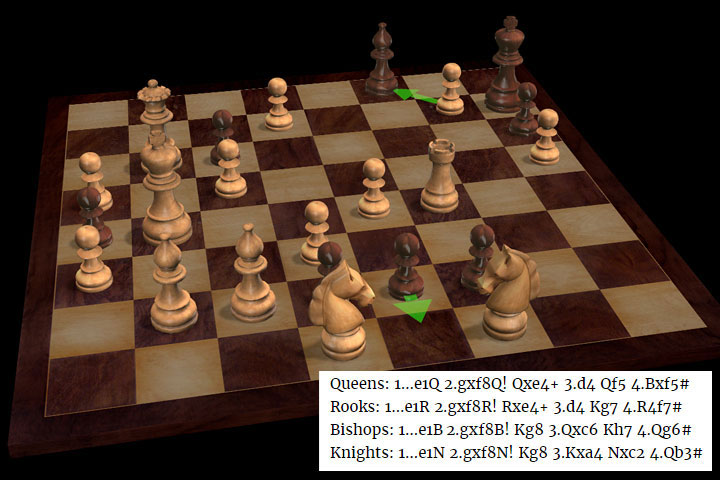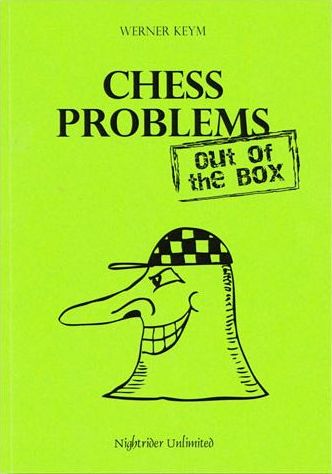


ChessBase 17 - Mega package - Edition 2024
It is the program of choice for anyone who loves the game and wants to know more about it. Start your personal success story with ChessBase and enjoy the game even more.
One of the most famous challenges in problem chess is the Babson Task. It entails composing a mate in four with four main lines. They consist of a defensive promotion of a black pawn to a queen, rook, bishop or knight, which forces White to promote to the same piece type in each case. As reported in the previous article “Revisiting Tim Krabbé and Babson” the first such “Echo-Babson” was presented in 1983 by a 26-year-old soccer and chess trainer from Kazan named Leonid Vladimirovich Yarosh — after French problem composer Pierre Drumare had spent 22 years of his life unsuccessfully attempting to compose one.
To date around 20 Babson problems have been published, but none in which the four main lines as well as the four-move side lines have all been free of duals. That would be the perfect Echo-Babson, but is it really possible? For anyone interested in delving deeper into the subject we can recommend the excellent (German language) treatise by Peter Hoffmann and Erik Zierke: “100 Years: Babson Task in the Orthodox Directmate.” It is 99 pages long (!) and discusses different versions of the Babson task, and especially, on pages 24-44, all currently known examples of the Echo-Babson. Here the English foreword of the paper:
Babson Task: All four different promotions of the same black pawn on the same field are followed each by the corresponding promotion of the same white pawn on the same field. In a broader sense, each assignment of the four black with the four white promotions is allowed.
In this documentation all 3/4- and 4/4-realizations (including 6/8- & 7/8-Babsons, see chapter II) in the directmate that we know are summarized (most we show with diagram, some as footnote; some pre-versions, or versions with minor changes, or incorrect versions are only mentioned). The solution notations accept duals in the thematic lines by “similar” moves as “minor”. Because of the (hopefully) broad interest we show solutions (and positions in text format) in English. So if your German is not good: ignore the comments and enjoy the problems! (All problems were tested with the version 2013 of Popeye.) If you know another realization, please send it to us! At the end of this documentation there is an overview about Babson combinations not yet realized.
Let us start with the magnificent problem by Leonid V. Yarosh (Hoffmann/Zierke p. 29).
The solution, after the wonderful key 1.a7!, unfolds in four main lines:
1...axb1Q 2.axb8Q! Qe4 3.Rxf4/Qxf4 Qxf4 4.Qxf4/Rxf4#; or 2...Qxb2 3.Qxb3 Qc3 4.Qaxc3/Qbxc3#
1...axb1R 2.axb8R! Rxb2 3.Rxb3 Kxc4 4.Qa4#
1...axb1B 2.axb8B! Be4 3.Bxf4 Bxa8 4.Be3/Be5#
1...axb1N 2.axb8N! Nxd2 3.Qc1 Ne4 4.Nc6#; or 3...N(any) 4.Rxf4#.
In addition there are interesting side lines after 1…Qe5/Qxd8+/Qd6/Qxa8 and the pretty try 1.Re1? Qxd8+! 2.Kg7 Qg8+ 3.Kxg8 stalemate. It is a top composition – but it is not quite perfect, since there are duals in the main line. Similarly in the “Problem of the Century” by Yarosh (Hoffmann/Zierke p. 30, the third Yarosh composition in our previous article) there are also minor duals in the main lines.
 The amazing Peter Hoffmann was the first problem composer to present a cyclical Babson task in orthodox moremovers without promoted pieces. The problem and many other Babson tasks can be seen in his 99-page Babson task paper.
The amazing Peter Hoffmann was the first problem composer to present a cyclical Babson task in orthodox moremovers without promoted pieces. The problem and many other Babson tasks can be seen in his 99-page Babson task paper.
Hoffmann, 63, lives in Braunschweig, Germany, where he is employed as a school librarian. In his free time he is an avid hiker. His chess talent is not limited to Babsons: in 2011 he was granted the title of FIDE Master, and a commented selection of his problems (in German) can be seen and downloaded on the Berlin Thema site.
Peter Hoffmann created the first Babson problem without duals in 1986 (Hoffmann/Zierke p. 37):
These are the four main lines after the (weak) key move 1.dxe7!
1… e1Q 2.exf8Q! Qxe4+ 3.d4 Qf5 4.Bxf5#
1… e1R 2.exf8R! Rxe4+ 3.d4 Kg7 4.R4f7#
1… e1B 2.exf8B! Kg8 3.Qa6 Kh7 4.Qg6#
1… e1N 2.exf8N! Kg8 3.Ka5 N any 4.Qc4#
In this problem there are alternate four-move side lines with different promotions, like 1...exd1Q and 1...exf1Q, which contain duals. This dilutes the thematic promotions and is thus a weakness. This weakness is eliminated in Hoffmann's version from 2009 (Hoffmann/Zierke p. 38), his finest Echo Babson:
1.fxg7! and now:
Queens: 1…e1Q 2.gxf8Q! Qxe4+ 3.d4 Qf5 4.Bxf5#
Rooks: 1…e1R 2.gxf8R! Rxe4+ 3.d4 Kg7 4.R4f7#
Bishops: 1…e1B 2.7xf8B! Kg8 3.Qxc6 Kh7 4.Qg6#
Knights: 1…e1N 2.gxf8N! Kg8 3.Kxa4 Nxc2 4.Qb3#
Here the alternate side lines with different promotions, or the defence 1...Kg8, result in mates in three moves, and are therefore unimportant. The four-move side lines 1…Bxc5+/Bd6/Be7/Bxg7 are weak defences (with duals). The thematic try 1.d8Q? e2xf1Q! 2.Qxf8 Qg2! 3.f6xg7 Qxe4+ on the other hand is quite appealing. (The solution is given in the replay board at the end of this article — you can switch on the engine and test other lines.)
 If we could meld this problem with Yarosh’s masterpiece we would have the perfect realisation of the Babson Task: a good key move, sophisticated threats, four dual-free echo promotions in the main lines, dual-free four-move side lines. Werner Keym would be happy with slightly less: in his book Chess Problems out of the Box he offers a prize of €100 for "a Babson problem without duals in all full length variants (main line and side lines)." There are similar prizes for other tasks on page 168 of the book.
If we could meld this problem with Yarosh’s masterpiece we would have the perfect realisation of the Babson Task: a good key move, sophisticated threats, four dual-free echo promotions in the main lines, dual-free four-move side lines. Werner Keym would be happy with slightly less: in his book Chess Problems out of the Box he offers a prize of €100 for "a Babson problem without duals in all full length variants (main line and side lines)." There are similar prizes for other tasks on page 168 of the book.
Werner Keym, from whom I got most of the material for this article, is a teacher (of French and Latin) and a musician who has organised more than 300 concerts in his town of Meisenheim, located near Frankfurt, Germany.
I would like to remind our readers that in 2010 Keym ran as an independent candidate for Mayor of the town and won in a landslide. He held that position until 2014, when at 72 he retired to devote more time to his family — he has five grandchildren — and to his hobbies. The foremost of them is problem chess, where he remains one of the most creative problemists I know.
Apart from the Babson Task we have been discussing, with the promotions QQ-RR-BB-NN, there are completely different types, for instance the Cyclical Babson (e.g. QB-BR-RS-SQ). Hoffman is so far the only composer to master this incredible challenge (Hoffmann/Zierke pp. 45-47).
Here are the main lines after the key 1.Nxb6!
1…d1Q 2.exf8B! Qd7 3.c8Q/B Qxc8 4.bxc8Q/B#; 2…Qd4+ 3.exd4 Kxf6 4.d5#
1…d1B 2.exf8R! Kd6 3.Qd2+Kc5 4.Qd5#; 3… Kxc6 4.c8Q#
1…d1R 2.exf8N+! Kd6 3.Be5+ Kc5 4.Qxc2#; 3… Kxc6 4.c8Q#
1…d1N 2.exf8Q! Nxc3+ 3.Kxa5 Nd5 4.c8Q,B#.
This is a unique achievement in spite of the unavoidable mate duals. The four-move side lines with different promotions (1…dxc1Q/R 2.exf8Q/B Q/Ra1+ 3.Rxa1) or the defence 1...Rxh8 and 1...Kd6 have duals.
There is another task that has not yet been achieved. It is the Reciprocal Babson, e.g. QN-NQ-RB-BR or QR-RQ-BN-NB. For the first successful realization of such a problem (in a legal position without promoted pieces) Werner Keym offers a prize of €1000. It is the highest prize ever offered for a chess problem. Submissions should be sent to w.keym at gmx dot net.
